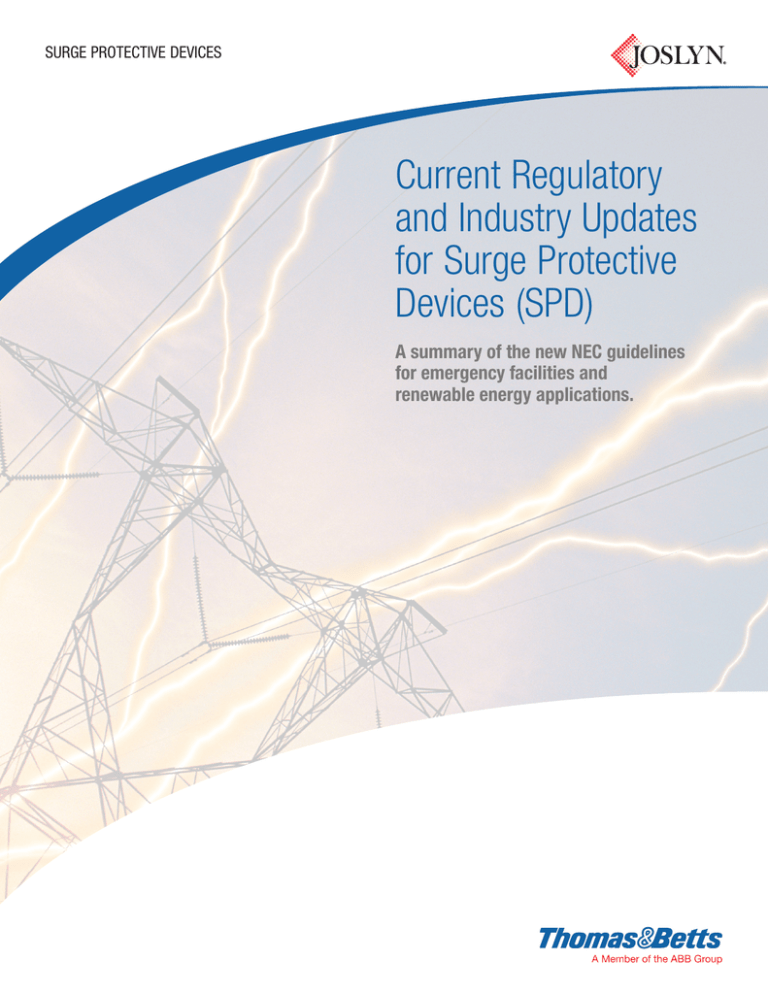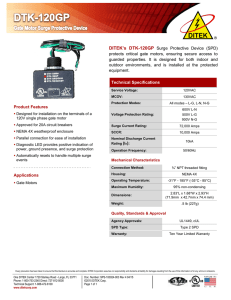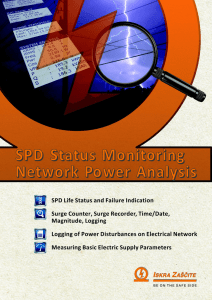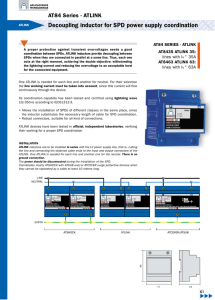
Surge Protective Devices
Current Regulatory
and Industry Updates
for Surge Protective
Devices (SPD)
A summary of the new NEC guidelines
for emergency facilities and
renewable energy applications.
The 2008 and 2014 National Electric Code (NEC ) guidelines
have expanded the requirements for where surge protection
devices (SPD) must be used to include emergency facilities
and renewable energy applications.
®
®
Since their proper function can be critical in an emergency or for the proper operation of the electrical grid,
it is important that the correct type of SPD be specified for these applications, so the methods used to test
their operation are important.
Anatomy of a Surge
Electrical surges can cause disruptions in computer signals
and microprocessors, degradation of component junctions
that cause random, delayed failure, or instant damage to
electrical components.
A power surge, or transient voltage, is an increase in voltage
significantly higher than the designated level in a flow of
electricity. In the United States, standard voltage for
residential and commercial structures is 120 volts. When the
voltage rises above this level, damage can occur to sensitive
electronic equipment.
While lightning might be thought to be the major cause of
electrical surges, it actually is one of the least common. Fully
80 percent of surges are caused by internal disturbances,
such as load switching, variable frequency drives, lighting
and HVAC systems. Even though surges from internal
disturbances are usually relatively low in intensity, they can
add up over time, weakening the sensitive circuitry in today’s
electronic devices.
External disturbances, like surges from utility line switching
or lightning, occur far less frequently than internal surges, but
their strength can be devastating. When lightning strikes
close to power lines, the electrical energy can boost electrical
pressure by millions of volts.
2
SPDs are designed to act like pressure-sensitive valves,
diverting this extra current to ground.
Microvaristor
Zinc oxide
Intergrandular
boundary
10 - 50 µm
At the heart of many SPDs are metal oxide varistors (MOV)
that have a crystalline structure inside, containing zinc oxide.
When exposed to over voltage, or a transient surge, the
varistors switch from a nearly open state to a clamping state.
This is enough to bridge the gaps within the crystalline
structure and the MOV becomes an active part of the circuit,
providing an attractive path to ground, protecting the
equipment downstream.
Turn-on Voltage: This is the level at which the MOV begins
to activate.
Both the NEC (in the 2008 and 2014 NEC ) and National
Electrical Manufacturers
Clamping Voltage (also referred to as “let-through
voltage”): This specifies the voltage that will be seen by the
downstream (connected) equipment. Clamping voltages vary
and are directly dependent upon the magnitude of the surge
seen by the SPD. Using the UL 1449 3rd Edition VPR (Voltage
Protective Rating) surge value of 6kV/3kA, a good clamping
voltage for a 120V system would be 700, or 800 volts. A
lower clamping voltage indicates better protection.
Association (NEMA ) specify that SPDs must be used for each
voltage level of the facility’s service entrance and distribution
panels:
®
®
®
• NEC Article 708.20 (D): “Surge protection devices shall be
provided at all facility distribution voltage levels.”
®
• 2014 NEC Article 700.8: “ A listed SPD shall be installed in
or on all emergency switchboards and panel boards.”
®
• NEC Article 240.21 (B) (1): “Where listed equipment, such
as a SPD, is provided with specific instructions on
minimum conductor sizing, the ampacity of the tap
conductors supplying that equipment shall be permitted to
be determined base on the manufacturer’s instructions.”
®
Eliminated Voltage
1,500v
........................................................
150v
........................................................
SPD
Clamped Voltage
Turn on Voltage
Wind Electrical System Protection
The 2014 NEC also specifies that SPDs must be
incorporated into wind-powered electrical supply systems to
prevent damage from surges.
®
Source
Load
Emergency Systems Surge Protection
• NEC Article 694.10 (D) states: “ A SPD shall be installed
between a wind electric system and any loads served by
the premises electrical system.”
®
New NEC guidelines have been established to identify critical
operations power systems (COPS) and to increase protection
and reliability of the power infrastructure for critical facilities.
Critical facilities include any entity that, if damaged, might
disrupt national security, the economy, public health or safety.
Obvious critical facilities would include:
• Law enforcement
• Fire departments
• Military installations
• Hospitals, doctors’ offices
• Financial institutions
• Water and wastewater
• Airports and air traffic control
• Traffic light systems
• All government agencies
3
Types of Surge Protection Devices
Type 1 SPD – Line Side
A Type 1 SPD is a permanently connected, hard-wired SPD
that can be installed on the line side of the main service
disconnect. This type of SPD is safe by itself and does not
require external over-current protection.
SPDs for mounting at
Service Entrance
SPDs for mounting on
Panelboards
Type 2 SPD – Load Side
A Type 2 SPD is a permanently connected, hard-wired SPD
intended for installation on the LOAD side of the service
disconnect over-current device, including SPDs located at the
branch panel. They are not safe by themselves, and require
an external fuse or breaker to trip to safely remove them from
the circuit.
SPDs for protection of downstream equipment
Type 3 SPD
Type 3 are point of utilization SPDs, installed a minimum of 10 meters (30 feet) from the electrical service panel, for example
cord connected, direct plug-in (DPI), receptacle type and SPDs installed at the utilization equipment being protected.
Type 4 SPD
Type 4 are component SPDs, including discrete components as
well as component assemblies. They consist of one or more Type
5 components assembled together with a disconnect (integral or
external) as a means of complying with the limited current tests.
Component SPDs
Type 5 SPD
Type 5 SPDs are discrete component surge suppressors (such as MOVs) that may be mounted on a printed circuit board,
connected by its leads or provided within an enclosure with mounting means and wiring terminations.
4
Ensuring Proper Function
Additional Resources
Surge Protection Devices are available in a range of ratings,
depending on the level of protection needed. They are used
to insure that electrical surges do not cause damage to
sensitive electronics. Higher surge ratings provide a higher
level of protection and greater redundancy for ensuring a
longer useful life. However, like any insurance policy, the
higher the level of protection specified, the higher the cost.
Here are some additional resources about the new NEC
guidelines for surge protection in emergency facilities and
renewable energy applications:
The ratings used to classify SPDs can be determined in two
ways:
• Calculated: The surge rating is the sum of all the MOVs in
a given mode or phase; three 50kA MOVs A-N would be
150 kA per mode. However, this does not take into account
design elements that may reduce the surge protection in
real world conditions, such as printed circuit board traces
used as surge current carrying paths in the design of the
SPD.
http://www.nemasurge.org/
The NEMA Surge Protection Institute (NSPI) is an
educational outreach effort initiated by the Low Voltage
Surge Protective Devices Section of the National Electrical
Manufacturers Association (NEMA).
http://www.mikeholt.com/necadoptionlist.php
A listing of each state and the status of NEC adoption.
• Independently verified: An independent testing labora tory
tests the SPD under real-world conditions to measure the
true protection capacity. This ensures the SPD will deliver
the level of protection it claims.
Considering the importance of the COPS facilities being
protected, a third-party laboratory should independently test
any SPD used in these applications.
5
AC Voltage SPD Applications and Location Guide
IEEE C62.41.2-2002 Category C
IEEE: Category C – Service Entrance Exposure
NEC 285 & NRTL: SPD Type 1, 2, or equivalent
Type 4
Type 1
SPD
Line Side
Service Entrance
N&G Bonded (i.e., L-N and L-G are same)
Higher available fault currents require
appropriate SCCR ratings
Historical kA ratings:
Per Phase: 400kA to 200kA per phase
Per Mode: 200kA to 100kA per mode
(Per Phase generally considered Sum of
L-N plus L-G)
Load Side
Type 1 or 2
SPD
Surge Current kA ratings for all
Categories are subjective. Consult
SPD mfg for specific
recommendations
IEEE: Category B – External remnant or
Internally Induced
IEEE C62.41.2-2002 Category B
Line side requires
Type 1 SPD per
NEC 285 & UL 1449
Distribution
NEC 285 & NRTL: SPD Type 1, 2, or equivalent
Type 4
L-N and L-G are different – need L-N, L-G,
and N-G
Require appropriate SCCR ratings
Historical kA Ratings:
Per Phase: 300kA to 100kA per phase
Per Mode: 150kA to 50kA per mode
(Per Phase generally considered Sum of
L-N plus L-G)
UL 96A Lightning
Protection System
SPDs at Service
Entrances require
20kA I-n and UL Mark
Indoor
HVAC (VFD)
Type 1 or
2 SPD
Indoor
Outdoor
Equipment installed outside of the building
could increase exposure level to Category C.
Consider effects of Ground Potential Rises
from direct lightning strikes to earth.
Wind or PV
Generation
Outdoor
Lighting
Type 1 or 2
SPD
Type 1 or
2 SPD
IEEE C62.41.2-2002 Category A
IEEE: Category A, maybe B, maybe C if outdoor
loads are connected
L-N and L-G are different – need L-N, L-G,
and N-G
Require appropriate SCCR ratings
Historical kA Ratings;
Per Phase: 160kA to 100kA per phase
Per Mode: 80kA to 50kA per mode
(Per Phase generally considered Sum of L-N
plus L-G)
Revision Date: April 14, 2014
6
Branch
NEC 285 & NRTL: SPD Type 1, 2, or equivalent
Type 4. Could be Type3.
Branch
“Pre” SPD
(Type 1)
Indoor
Lighting
UPS
(or PDU, PDM)
“Post” SPD
Computers or
Servers
Type 1 or 2
SPD
Outdoor
Lighting
Images depected herein are for demonstration purposes. Each facility is different and user
needs may vary. Adjust accordingly, based on equipment value and/or downtime expenses.
Provided by NEMA
Relevant SPD Standards (1000V and Less):
• ANSI/UL 1449 – Surge Protective Devices
• UL 1283 – EMI/RFI Filtering
• ANSI/IEEE C62.41.1-2002 – Guide on Surge Environment
• ANSI/IEEE C62.41.2-2002 – Characterization of Surges
• ANSI/IEEE C62.45-2002 – Testing
• IEEE C62.62-2010 – Testing
• IEEE C62.72-2007 – Application Guide
Gen Set
ATS / STS
Type 1 or 2
SPD
Load side of the Switch protects
Service and Gen Set
Distribution
Type 1 or 2
SPD
Type 1 or 2
SPD
MCC
Type 1 or 2
SPD
Outdoor
HVAC (VFD)
Busway
Type 1 or 2
SPD
Type 1 or 2
SPD
Type 1 or 2
SPD
Protect both ends of the busway against reflections
Establishes a new reference to ground, like a service entrance.
L-N only may be sufficient
Type 3
SPD
Type 1 or 2
SPD
Separately Derived System
Small or Office
Equipment
Type 1 or 2
SPD
Branch
Type 1 or 2
SPD
Indoor
Branch
Outdoor
Type 1 or 2
SPD
Outdoor
Equipment
Type 1 or 2
SPD
Equipment
Type 1 or
2 SPD
Series
SPD
Equipment installed outside of the building could increase exposure level to Category C.
Consider effects of Ground Potential Rises from direct lightning strikes to earth
Equipment
Series or two-port SPDs may disconnect downstream
loads at end of life
7
Visit the T&B world of
electrical product solutions
Visit our web site for more information about Thomas & Betts
solutions and our newest products. For a user-friendly
catalog and competitive part number search, application
and technical support and other useful information,
go to: www.tnb.com
Industry codes and specifications
Thomas and Betts surge protection devices meet or exceed
applicable industry specifications or codes which are detailed in
the appropriate T&B product literature.
Online CAD library
Thomas & Betts offers free download of two- and threedimensional CAD models of many of its products in more
than 90 native CAD formats at: www.tnb.com/cadlibrary
American Recovery and Reinvestment Act (ARRA)
United States
Europe/Africa
Thomas & Betts Corporation
Electrical Division Headquarters
8155 T&B Boulevard
Memphis, TN 38125
Phone: 901.252.8000
Fax: 901.252.1354
Technical Services:
888.862.3289
Customer Service:
1.800.816.7809
Email: elec_custserv@tnb.com
T&B European Centre
200 Chaussée de Waterloo
B-1640 Rhode-St-Genèse
Belgium
Phone: +32.235.98200
Email: europe_inquiry@tnb.com
Thomas & Betts Power Solutions
5900 Eastport Blvd., Bldg. V
Richmond, VA 23231
Phone: 800.238.5000
Fax: 804.236.4040
Thomas & Betts Ltd
PO Box 54567
Office 107 5EA East Wing
Dubai Airport Free Zone
Dubai
United Arab Emirates
Phone: +9714.609.1635
Fax: +9714.609.1636
Email: me_ex_enquiry@tnb.com
Canada
Asia Pacific
Thomas & Betts Ltd
700 Avenue Thomas
St.-Jean-sur-Richelieu
Quebec J2X 2M9
Phone: 450.347.5318
Fax: 450.347.1976
Thomas & Betts Asia Pte Ltd
10 Ang Mo Kio Street 65
#06-07 Techpoint
Singapore 569059
Phone: +65.6720.8828
Fax: +65.6720.8780
Email: asia_inquiry@tnb.com
Latin America
Mexico: 01-800-TNB-HELP
Central America & Caribbean:
+52.81.8329.7707
South America:
+52.81.8329.7643
Email: servicioalcliente@tnb.com
Get certification letters for
compliant products online at:
www.tnb.com/ARRA
© 2015 Thomas & Betts Corporation. All rights reserved. Printed in the U.S.A.
02/18/15
Middle East
Thomas & Betts Corporation
5900 Eastport Blvd., Bldg. V
Richmond, VA 23231
Phone: 800.238.5000
www.tnbpowersolutions.com






